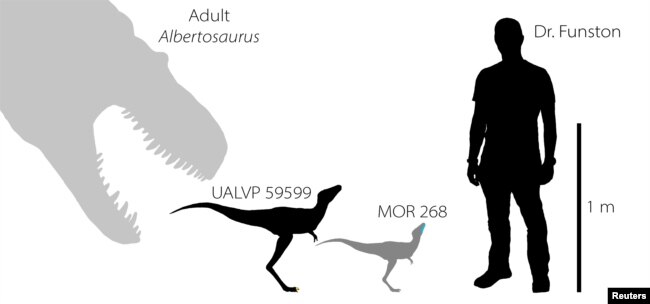ティラノサウルス郡の赤ちゃん発見!!

アーティストによって描かれた、北米白亜紀のティラノサウルスの赤ちゃん。
これだけだと”可愛い”のですが、生まれながらにして、ハンティング能力を備え、、その卵はなんと43cmより大きいというのですから、お・ど・ろ・き !!
今日のVOA, Science&Technology より。
Let's listenning!!
科学者たちがティラノサウルス群から初めての赤ちゃんの遺骨を発見
Scientists Find First Baby Remains from Tyrannosaurus Group
January 28, 2021
科学者たちは初めて、ティラノサウルス・レックスを含む肉食恐竜のグループの赤ちゃんの遺骨を発見しました。
研究者は最近、顎と爪の骨は、大きな赤ちゃんが大人によく似ていて、狩りをするために”生まれながらにして準備ができていた”ことを示していると述べています。
化石とも呼ばれるこの骨は、ティラノサウルスと呼ばれるグループの2つの種を代表するものでした。ティラノサウルスは、恐竜時代末期のアジアと北米のトップハンターでした。
骨は、これらの赤ちゃんが他の知られている恐竜の赤ちゃんよりも大きかったことを示唆しています。おそらく体長は1メートル前後だったと思われます。彼らは、おそらく現在知られている最大の恐竜の卵である約43センチよりも大きい、非常に大きな卵であったに違いないものから生まれました。
顎の骨は約7700万年前のもので、長さは約3センチ。モンタナ州で発見されたもので、ダスプレトサウルスという種に属する可能性があります。
爪は約7200万年前のもの。カナダから来たもので、アルバートサウルスという種に属する可能性があります。
これらの種はいずれもティラノサウルス・レックスの小型のいとこと考えられています。既知の最大のティラノサウルスは体長12メートルを超えていました。
エジンバラ大学のグレッグ・ファンストン氏は、カナディアン・ジャーナル・オブ・アース・サイエンス誌に掲載された研究の筆頭執筆者であす。彼によると、科学者たちは、その骨が古いティラノサウルスの骨と似ていることに驚いたといいます。ファンストン氏は、顎には働く歯があったことを指摘しています。
「ですから、全体像を把握することはできませんが、見られるものは大人に非常によく似ています」と彼は言います。
 アメリカのモンタナ州とカナダのアルバータ州で出土した部分化石をもとに、北米白亜紀に生息する2頭のティラノサウルスの赤ちゃんのシルエットを、エジンバラ大学のグレッグ・ファンストンのシルエットと大人のアルバートサウルスのシルエットでサイズ比較したイラスト。Greg Funston/University of Edinburgh/Handout via REUTERS
アメリカのモンタナ州とカナダのアルバータ州で出土した部分化石をもとに、北米白亜紀に生息する2頭のティラノサウルスの赤ちゃんのシルエットを、エジンバラ大学のグレッグ・ファンストンのシルエットと大人のアルバートサウルスのシルエットでサイズ比較したイラスト。Greg Funston/University of Edinburgh/Handout via REUTERS
ティラノサウルスは、”ティラノサウルスに強力な噛みつきを与えた重要な適応のいくつかをすでに持っていて、狩りをする準備ができて生まれてきた”とファンストンは付け加えています。
適応とは、動物が特定の場所や状況でより良く生きられるようにするための変化を意味する用語です。
ファンストン氏は、ティラノサウルスの赤ちゃんは”生まれてからかなり早く狩りができるようになっていたようです、しかしそれがどのくらいの速さであったかを正確に知るには、より多くの化石が必要です。”と語っていました。
Scientists Find First Baby Remains from Tyrannosaurus Group
 A baby tyrannosaur from the Cretaceous Period of North America, based on partial fossils unearthed in the U.S. state of Montana and in the Canadian province of Alberta, is seen in an undated artist's rendition. (Julius Csotonyi/Handout via REUTERS )
A baby tyrannosaur from the Cretaceous Period of North America, based on partial fossils unearthed in the U.S. state of Montana and in the Canadian province of Alberta, is seen in an undated artist's rendition. (Julius Csotonyi/Handout via REUTERS )
For the first time, scientists have found the remains of babies from the group of meat-eating dinosaurs that includes Tyrannosaurus rex.
Researchers said recently that the jaw and claw bones show that the large babies looked a lot like adults and were “born ready” to hunt.
The bones, also called fossils, represented two species from the group called tyrannosaurs. Tyrannosaurs were the top hunters in Asia and North America toward the end of the dinosaur age.
The bones suggested that these babies were bigger than any other known dinosaur babies. They were probably around one meter long. They came from what must have been very large eggs, perhaps larger than the largest dinosaur eggs currently known, which are about 43 centimeters.
The jawbone is around 77 million years old and about 3 centimeters in length. It was found in Montana and may belong to a species called Daspletosaurus.
The claw is around 72 million years old. It came from Canada and may belong to a species called Albertosaurus.
Both of these species are believed to be smaller cousins of Tyrannosaurus rex. The largest known tyrannosaurs were over 12 meters long.
Greg Funston of the University of Edinburgh was the lead writer of the research that appeared in the Canadian Journal of Earth Sciences. He said the scientists were surprised at how similar the bones were to older tyrannosaurs. Funston noted that the jaws had working teeth.
“So although we can’t get a complete picture, what we can see looks very similar to the adults,” he said.
It appears that tyrannosaurs, Funston added, were “born ready to hunt, already possessing some of the key adaptations that gave tyrannosaurs their powerful bites.”
Adaptation is a term that means a change in an animal that makes it better able to live in a particular place or situation.
Funston said it was “likely” that the baby tyrannosaurs “were capable of hunting fairly quickly after birth, but we need more fossils to tell exactly how fast that was.”
________________________________________________________________
Words in This Story
jaw – n. either one of the two bones of the face where teeth grow
claw – n. a sharp curved part on the toe of an animal (such as a cat or bird)
species – n. biology : a group of animals or plants that are similar and can produce young animals or plants : a group of related animals or plants that is smaller than a genus
capable – adj. having the ability to do or have something